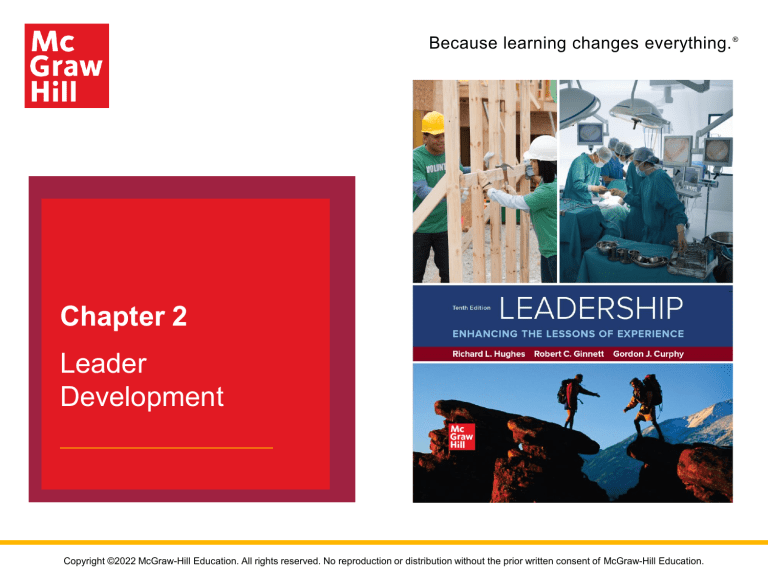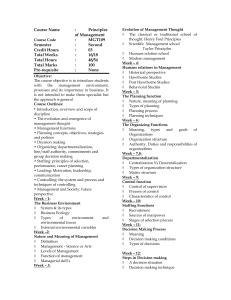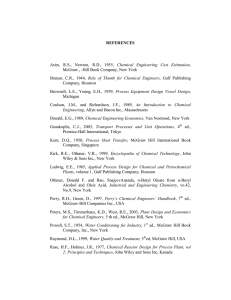
Because learning changes everything. ® Chapter 2 Leader Development Copyright ©2022 McGraw-Hill Education. All rights reserved. No reproduction or distribution without the prior written consent of McGraw-Hill Education. Chapter Outline • • • • • Introduction The action–observation–reflection model The key role of perception in the spiral of experience Reflection and leadership development Making the most of your leadership experiences: learning to learn from experience • Building your own leadership self-image © McGraw Hill 2 Leader Development There are structured and planned approaches to developing internal leaders or leaders-to-be. • Formal training is the most common approach to developing leaders. • Although research consistently shows that it’s not the most effective method. Leadership and learning are indispensable to each other. • John F. Kennedy. © McGraw Hill 3 The Action–Observation–Reflection Model Shows that leadership development is enhanced when the experience involves the following processes: • Action • Observation. • Reflection Spiral of experience. • Most productive way to develop as a leader. © McGraw Hill 4 Figure 2.1: The Spiral of Experience Access the text alternative for slide images. © McGraw Hill 5 Key Role of Perception in the Spiral of Experience • Experience depends on what events happen to one and how one perceives those events. • Perception affects all three phases of the action, observation, and reflection model. • People actively shape and construct their experiences. © McGraw Hill 6 Perception and Observation Observation and perception both deal with attending to events around a person. People are selective in what they attend to and what they perceive. • A phenomenon that demonstrates this selectivity is called perceptual set. • Perceptual set can influence any of one’s senses. • It is the tendency or bias to perceive one thing and not another. • Feelings, needs, prior experiences, and expectations can all trigger a perceptual set. Stereotypes about gender, race, and the like represent powerful impediments to learning because they function as filters that distort one’s observations. © McGraw Hill 7 Perception and Reflection 1 Perception influences reflection. • Reflection is how humans interpret their observations. Perception is inherently an interpretive, or a meaning-making, activity, of which attribution is an important aspect. • Attributions: Explanations that one develops for the characteristics, behaviors, or actions to which he or she attends to. © McGraw Hill 8 Perception and Reflection 2 Factors that affect the attribution process. • Fundamental attribution error: Tendency to overestimate the dispositional causes of behavior and underestimate the environmental causes when others fail. • Self-serving bias: Tendency to make external attributions for one’s own failures and make internal attributions for one’s own successes. • Actor or observer difference: Refers to the fact that people who are observing an action are much more likely than the actor to make the fundamental attribution error. Apart from perception and attribution, reflection also involves higher functions like evaluation and judgment. © McGraw Hill 9 Perception and Action Research shows that perceptions and biases affect supervisors’ actions toward poorly performing subordinates. Self-fulfilling prophecy is a perceptual variable that can affect actions. • Self-fulfilling prophecy: Occurs when one's expectations or predictions play a causal role in bringing about the events he or she predicts. • A person’s expectations about another may influence how he acts toward her, and in reaction to his behavior she may act in a way that confirms his expectations. © McGraw Hill 10 Reflection and Leadership Development • Reflection offers leaders insights about framing problems differently, viewing situations from multiple perspectives, and understanding subordinates better. • Managers tend to ignore reflection because they lack time or because of their taken-for-granted beliefs about leadership that many people have. • Leadership development can be enhanced by raising implicit beliefs to conscious awareness in order to aid thoughtful reflection. © McGraw Hill 11 Fundamental Archetypes of Leadership • Teacher and mentor • Father and judge • Warrior and knight • Revolutionary and crusader • Visionary and alchemist © McGraw Hill 12 Single- and Double-Loop Learning Single-loop learners seek relatively little feedback that may significantly confront their fundamental ideas or actions. • Individuals learn only about subjects within the comfort zone of their belief systems. Double-loop learning involves being willing to confront one’s own views and inviting others to do the same • Mastering double-loop learning is viewed as learning how to learn. • Unaided learning is enhanced through a practice of systematic reflection or after event reviews or A E Rs. © McGraw Hill 13 Making the Most of One's Leadership Experiences: Learning to Learn from Experience • Learning events and developmental experiences that punctuate one’s life are stressful. • Being able to go against the grain of one’s personal historical success requires a strong commitment to learning and a willingness to let go of the fear of failure and the unknown. • To be successful, learning must continue throughout life and beyond the completion of one’s formal education. © McGraw Hill 14 Leader Development in College 1 Programs on leadership studies are being offered by many higher education institutions and colleges. Leadership programs should be multidisciplinary and should cultivate values represented in the broader field. • Service learning is used to inculcate values such as social responsibility and the expectation to become engaged in one’s community. • Should focus on expected developmental outcomes, with associated assessment and evaluation to determine program effectiveness. © McGraw Hill 15 Leader Development in College 2 Some key curricular components of college-based leadership studies programs include coursework examining, foundational theories, and concepts in leadership. Different leader development methods may be used beyond service learning. • Some courses or program elements might involve individualized feedback to students in the form of: • Personality, intelligence, values, or interest test scores. • Leadership behavior ratings. © McGraw Hill 16 Leader Development in College 3 • Case studies and role playing are used as vehicles for leadership discussions. • Simulations and games are structured activities designed to mirror the challenges or decisions commonly faced in the work environment. © McGraw Hill 17 Leader Development in Organizational Settings 1 • Leader development provided in organizations is not just for the individual’s personal development but also (and maybe primarily) for the organization’s benefit. • Research indicates that return on investment or R O I for investments used in leadership development are both positive and substantial. • Numerous leadership training programs are aimed at leaders and supervisors in industry and public service. © McGraw Hill 18 Leader Development in Organizational Settings 2 Program content depends on the organization level of participants. • First-level supervisors. • Mid-level managers. © McGraw Hill 19 Leader Development in Organizational Settings 3 Programs for first-level supervisors use lectures, case studies, and roleplaying exercises to improve supervisory skills The programs for mid-level managers focus on: • Improving interpersonal, oral communication, and written communication skills • Giving tips on time management, planning, and goal setting © McGraw Hill 20 Leader Development in Organizational Settings 4 Mid-level manager programs rely on individualized feedback, case studies, presentations, role-playing, simulations, and in-basket exercises to help leaders develop. • Participants are given a limited amount of time to prioritize and respond to a number of notes, letters, and phone messages from a fictitious manager’s in-basket • In-basket exercises are useful in assessing and improving a manager’s planning and time management skills. © McGraw Hill 21 Leader Development in Organizational Settings 5 Conger states that a multi-tiered approach is effective and should focus on personal growth, skill building, feedback, and conceptual awareness. Some approaches to leadership development emphasize individualized feedback about each person’s strengths and weaknesses based on standardized assessment methods. • Others emphasize that leader development in the 21st century must occur in more lifelike situations and contexts. Leadership programs for senior executives and CEOs focus on strategic planning, public relations, and interpersonal skills. © McGraw Hill 22 Action Learning Traditional training programs involve personnel taking leadership classes during work hours. • Such training addresses common leadership issues, but its artificial nature makes it difficult to transfer concepts to actual work situations. Action learning refers to the use of actual work issues and challenges as the developmental activity itself. • Works on the philosophy that best learning involves learning by doing. • Conducted in teams of work colleagues who are addressing real company challenges. © McGraw Hill 23 Development Planning 1 To make enduring behavioral changes, leaders must provide positive answers to the following five questions: • Do leaders know which of their behaviors need to change? • Is the leader motivated to change these behaviors? • Do leaders have plans in place for changing targeted behaviors? • Do leaders have opportunities to practice new skills? • Are leaders held accountable for changing targeted behaviors? © McGraw Hill 24 Development Planning 2 • Good development plans are constantly being revised as new skills are learned or new opportunities to develop skills become available. • Development planning provides a methodology for leaders to improve their behavior even as they go about their daily work activities. © McGraw Hill 25 Coaching A key leadership skill that can help leaders improve the bench strength of the group, which in turn should help the group accomplish its goals. Can help retain high-quality followers. Process of equipping people with the tools, knowledge, and opportunities they need to develop and become more successful. Types of coaching. • Informal coaching: Takes place whenever a leader helps followers to change their behaviors. • Formal coaching programs: Designed for the specific needs and goals of individual executives and managers in leadership positions. © McGraw Hill 26 Peterson and Hicks: The Five Steps of Informal Coaching • Forging a partnership • Inspiring commitment • Growing skills. • Promoting persistence • Shaping the environment © McGraw Hill 27 Informal Coaching • Process can be used to diagnose why behavioral change is not occurring and what can be done about it. • Can and does occur anywhere in the organization and is effective for both high-performing and low-performing followers. • Increases in difficulty when it occurs either remotely or across cultures. © McGraw Hill 28 Features of Formal Coaching 1 One-on-one relationship between manager and coach lasts from six months to more than a year. • Process begins with an assessment of the manager to clarify development needs. • Coach and manager meet regularly to review the results of the feedback instruments. © McGraw Hill 29 Features of Formal Coaching 2 • Role plays and video recordings are used extensively, and coaches provide immediate feedback. • Outcomes of coaching programs. • Clarification of managers’ values. • Identification of discrepancies between managers’ espoused values and their actual behaviors. • Development of strategies to better align managers’ behaviors with their values. © McGraw Hill 30 Features of Formal Coaching 3 • Formal coaching programs can cost more than 100,000 dollars. • Coaching may be more effective at changing behavior than more traditional learning and training approaches. © McGraw Hill 31 Mentoring 1 Personal relationship in which a more experienced mentor acts as a guide, role model, and sponsor of a less experienced protégé • Mentor: Experienced person willing to take an individual under his or her wing. • Usually someone two to four levels higher in an organization. • Provides protégés with knowledge, advice, challenge, counsel, and support about career opportunities, organizational strategy and policy, and office politics. © McGraw Hill 32 Mentoring 2 Not the same as coaching because: • It may not target specific development needs. • Guidance is provided by someone several leadership levels higher in the organization and not the immediate supervisor. • Mentor may not even be part of the organization. © McGraw Hill 33 Mentoring 3 There are formal and informal mentoring programs. • Informal mentoring occurs when a protégé and mentor build a longterm relationship based on friendship, similar interests, and mutual respect. • In a formal mentoring program, the organization assigns a relatively inexperienced but high-potential leader to a top executive in the company. • Often used to accelerate the development of female or minority protégés. Informal mentoring may be more effective than formal mentoring as it creates a stronger emotional bond and can last a lifetime. © McGraw Hill 34 Building One's Own Leadership Self-Image Not everyone wants to be a leader or believes he or she can be. • Many people are selling themselves short. People who want to avoid the responsibilities of leadership should keep an open mind about the importance and pervasiveness of leadership. © McGraw Hill 35 Summary One way to add value to one's leadership courses and experiences is by applying the action, observation, and reflection model. To become a better leader, one must seek challenges and try to make the best of any leadership opportunity. Behavior change efforts are most successful if some formal system or process of behavioral change is put into place. • These systems include action learning, development planning, informal and formal coaching programs, and mentorships. Leaders can help their followers with behavioral change through coaching or mentoring programs. © McGraw Hill 36 Because learning changes everything. ® www.mheducation.com Copyright ©2022 McGraw-Hill Education. All rights reserved. No reproduction or distribution without the prior written consent of McGraw-Hill Education.






